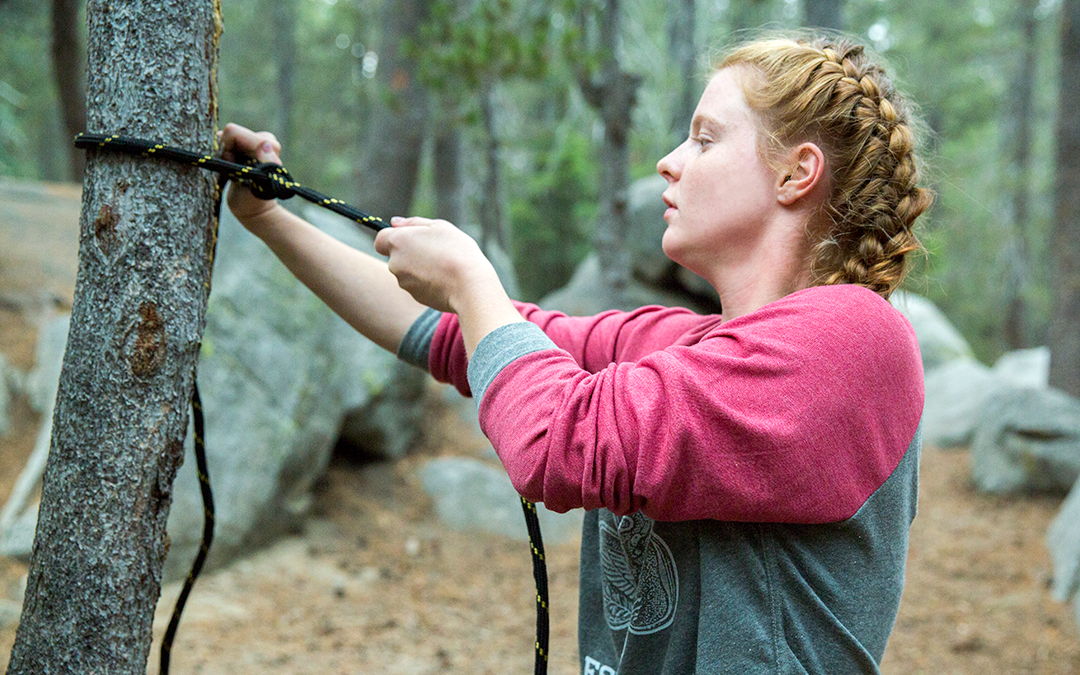Rope, yarn, string, lacing cord, paracord, the things you can tie goes on and on. We’ve all tied our shoelaces, but knot tying is so much more than just looping some string and pulling really tight—it’s an essential skill for taking on the outdoors. In most outdoor activities, your safety relies on the accuracy of your knots. Some knots work better than others, and it’s important to know when and how to tie the necessary knots.
Whether your Girl Scouts want to climb a mountain or dock a boat, here are 10 notable knots to show you and your girls the ropes and help them take their knot tying skills beyond the basic loop-de-loop-and-pull.
Basic Knot Vocabulary
Jam: When a knot becomes permanent, or so tight to the point of being unable to untie it.
Loop: A full circle formed by passing a rope over itself.
Running End: The “moving” portion of the rope that is used to thread the knot itself.
Standing End: The “still” portion of the rope that remains fixed in place throughout the knot tying process.
Stopper Knot: A type of knot used to make a portion of the rope thicker and prevent it from unraveling.
Round Turn: A full encirclement of the rope.
Half Hitch: A knot that runs around the standing end and through the loop formed.
Hitch: Attaches a rope to another object (relies on the object to hold its own shape.)
Bight: A “u” shaped loop; the slack part of the rope.
Bend: A type of knot used to join two ropes together.
The Overhand Knot
The simplest of the bunch, but also one of the most essential knots: the overhand. When pulled tight, the overhand knot is a sturdy knot that holds its own (literally, that’s why it’s the go-to stopper knot for everything from climbing to shoelace-tying). Once you and your girls master this knot, you’ll be able to apply this technique to more complex knots.
The Round Turn and Two Half Hitches
This knot has multiple components, but is the easiest knot for securing rope to fixed objects like poles and trees. The round turn and two half hitches knot is a more dynamic knot that can self-tighten, but isn’t too hard to untie. For this knot, the running end is going to be shorter than the standing end, so make sure it’s not too short—if it’s too short and the ends get loose, your knot will come undone!
Pro Tip: If your knot is going to hold heavy loads, add multiple round turns to make it more secure.
The Clove Hitch
Like the round turn and two half hitches knot, the clove hitch is used for securing rope to fixed objects. Girl Scouts use this knot all the time on climbing rope, bandages, and even hammocks, because the knot holds tight under tension—and when your body weight is on the line, a sturdy knot is essential.
The Square or Reef
Some call it the square knot, others call it the reef knot, but this timeless knot has been around since the ancient Greeks used it for healing, protection, and weddings (ever heard of “tying the knot”?). Once you get the hang of it, the square knot is quick and easy, which is why it’s the primary knot in macramé textile projects.
Pro Tip: This one can get a little tricky, so use two different-colored ropes when practicing to really understand the relationship between the two half hitches.
The Sheet Bend
Building off the square/reef knot, the sheet bend can also be used to join two ropes of different sizes. Even though this knot is useful in tying together ropes of different diameters and textures, that doesn’t mean they have to be. For example, fishing nets are just a collection of similarly sized sheet bend knots.
By itself, the sheet bend isn’t very secure (the knot requires constant tension to prevent it from coming loose), but together they can weave something neat (or should I say net)!
The Bowline
The bowline knot is similar to the sheet bend, but only uses one piece of rope (and creates a bowl-like loop). The bowline is a strong, reliable knot with a loop that makes it easy for sailors and campers alike to secure their precious cargo.
The Bowline on a Bight
You thought the bowline knot was strong? Well, the u-shape bight adds another level of strength to the bowline knot, which is why they’re used in rescue missions—the double loops make the knot secure enough to support a person’s body weight!
The Taut Line Hitch
Like the round turn and two half hitches and the clove hitch, the taut line hitch is used for securing rope to fixed objects. The taut line hitch is a bit more challenging than the previous hitch knots due to its many turns and loops. If you have outdoorsy Girl Scouts, this knot is essential for tying down tarps and tents!
The Cleat Hitch
This nautical knot is a must for those mariner Girl Scouts. If you’re still growing your sea legs, a cleat is t-shaped piece (usually wood or metal) on the dock that deckhands tie the boat to. So if you don’t want your boat to float away, make sure you practice this one!
The Double Figure Eight
With a name like double figure eight, it’s no surprise this knot has more twists, turns, and direction changes. This knot is definitely the complex and heavy-duty on the list. When done right, this multiple loop knot will be able to help your girls belay down the side of a mountain or even tow a car out of the mud!
Like any new skill, all of these knots will take practice. Your fingers may get tangled and your girls may feel tied up, but once you get the hang of it, your girls will have a whole new world of adventures at their fingertips. Crafting, first aid, climbing, sailing—try naming a Girl Scout activity that doesn’t require some knot tying. Like the knots, keep it tight!
What to do next:
- Bookmark the entire How to Tie Knots playlist on YouTube and keep practicing!
- Want to put your knot tying skills to the test? Join the Mariner Girl Scout or High Adventure GSNorCal Interest Groups, or find a camp program that will put your outdoor skills through their paces.
- Looking to take your knot tying skills to the next level? Check out Animated Knots for more knot-tying tutorials and knot activities.

Leah Takahashi—Leah is the Marketing Manager for Girl Scouts of Northern California, where she creates content, plans blog posts, and promotes all things Girl Scouts in all formats digital. Leah joined Girl Scouts at the age of 5 and has been a part of the organization ever since (shout out to Troop 31213 – woot woot). During her younger Girl Scout days, Leah did everything from selling thousands of Girl Scout Cookies to serving as a National Delegate at the 2011 Convention and even earning her Gold Award in 2012. She may be young, but she’s got plenty of Girl Scout experience under her belt and is excited to share it with you!



Hi! I would love it if Girl Scouts would publish a visual PDF guide troop leaders can use as a quick reference for knots something that’s maybe two pages so I could laminate it and take it to camp. Boy Scouts has one which is great–having one with Girl Scouts and the GS logo on it would be SO helpful.
Hi Shannon, Thank you for your suggestion of a knot guide for troop leaders. A knot guide is something that I would like to complete and have available on the resource page of our Camp Out in-person training. My goal is to work on that this summer and to have it available by fall.
We are doing Knots next week at Day Camp! Perfect timing. Thanks for the resources.
– Woodstock!